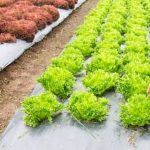Small backyard vegetable gardens are a wonderful way to make the most out of limited outdoor space. Whether you have a small yard, patio, or balcony, growing your own vegetables at home comes with numerous benefits. From saving money on groceries to enjoying fresh and organic produce, small backyard vegetable gardens can be both rewarding and fulfilling.
In this article, we will explore the various advantages of cultivating a small backyard vegetable garden and provide valuable tips for maximizing your limited space. We will also discuss different techniques such as container gardening and vertical gardening to help you get started on your journey to becoming a successful urban gardener.
Additionally, this article will cover essential topics such as selecting the right vegetables for small spaces, soil preparation and maintenance, pest control using natural and organic solutions, and harvesting your bountiful yield. With the right knowledge and approach, anyone can transform their small backyard into a thriving vegetable garden. So roll up your sleeves and get ready to enjoy the many benefits of growing your own fresh produce in a small space.
Assessing Your Space
When it comes to small backyard vegetable gardens, the key is to make the most of the limited space available. With some careful planning and creativity, even a small backyard can yield a bountiful harvest of fresh, homegrown produce. Here are some tips for assessing your space and maximizing its use for a successful vegetable garden:
- Make a plan: Assess the available space in your backyard and create a detailed plan of where you want to place your vegetable garden. Consider factors such as sunlight, shade, water access, and any potential obstacles like trees or structures.
- Utilize raised beds: Raised beds are a great option for small backyard vegetable gardens, as they allow you to maximize growing space and improve drainage. They also make it easier to control soil quality and prevent weed growth.
- Vertical gardening: Make use of vertical space by growing vining vegetables such as tomatoes, cucumbers, or beans on trellises or fences. This not only saves ground space but also adds visual interest to your garden.
- Intercropping: Planting different crops close together can help maximize space and increase yields. For example, you can plant quick-maturing lettuce or radishes between slower-growing crops like tomatoes or peppers.
By carefully assessing your small backyard space and implementing these strategies, you can create a productive and thriving vegetable garden that makes the most of every square foot available. With some creativity and thoughtful planning, even the smallest backyard can be transformed into a fruitful oasis of homegrown produce.
Selecting the Right Vegetables for Small Spaces
When it comes to small backyard vegetable gardens, choosing the right vegetables is crucial to make the most of the limited space available. With careful selection, even the smallest of spaces can yield a bountiful harvest. Here are some tips for choosing the best crops for your small backyard vegetable garden.
Consider Compact Varieties
When space is at a premium, it’s important to choose vegetable varieties that are well-suited for small gardens. Look for compact or dwarf varieties of your favorite vegetables, as these plants tend to take up less space while still producing an abundant harvest. For example, bush varieties of tomatoes and cucumbers are ideal for small gardens, as they can be easily grown in containers and require minimal support.
Focus on High-Yield Crops
In a small backyard vegetable garden, it’s essential to prioritize high-yield crops that will provide the most bang for your buck in terms of space and effort. Leafy greens like lettuce and spinach, as well as fast-growing vegetables such as radishes and green beans, are great choices for small spaces. These crops can be harvested continuously throughout the growing season, allowing you to make the most of your limited garden space.
Plan for Succession Planting
Succession planting involves sowing new seeds or transplanting seedlings as soon as one crop is harvested, ensuring a continuous supply of fresh produce throughout the season. This technique is especially beneficial in small gardens where space is limited. Choose vegetables that have a short growing season and plan your planting schedule accordingly to maximize your garden’s productivity.
By selecting the right vegetables and implementing strategic planting techniques, you can create a thriving garden in even the smallest of backyard spaces. Through thoughtful planning and careful consideration of crop selection, you can enjoy a diverse and plentiful harvest from your small backyard vegetable garden.
Container Gardening
One of the most effective ways to maximize a small backyard for vegetable gardening is through container gardening. This method allows you to utilize every inch of your limited space, whether it’s a patio, balcony, or a small patch of soil. With container gardening, you can grow a variety of vegetables, herbs, and even fruits without the need for ample garden beds.
When choosing containers for your small backyard vegetable gardens, opt for pots and planters that are at least 12 inches in diameter and depth. This will provide enough space for the roots to grow and allow for proper drainage. Additionally, consider using hanging baskets and vertical planters to make the most of your vertical space and create a lush garden even in a small area.
To ensure successful container gardening in limited spaces, it’s essential to select the right vegetables that thrive well in pots. Some great options include tomatoes, peppers, lettuce, spinach, radishes, and herbs like basil and cilantro. These plants are not only suitable for containers but also yield bountiful harvests even in small spaces.
In addition to selecting the right containers and vegetables for your small backyard vegetable gardens, it’s important to provide adequate care such as regular watering, fertilizing as needed, and monitoring for pests and diseases. By paying attention to the specific needs of your container plants, you can enjoy a flourishing garden even in the smallest of spaces.
| Vegetable | Container Size (Inches) |
|---|---|
| Tomatoes | 16+ diameter |
| Peppers | 12+ diameter |
| Lettuce | 12+ diameter |
Vertical Gardening
In small backyard vegetable gardens, every inch of space counts. One great way to maximize the use of small spaces is through vertical gardening. By utilizing walls and fences, you can grow a variety of vegetables without taking up valuable ground space. Vertical gardening not only adds visual interest to your backyard, but it also allows for better air circulation and sunlight exposure for your plants.
When it comes to vertical gardening in small backyard vegetable gardens, there are several options to consider. You can use wall-mounted planters, trellises, or even repurpose items like old ladders or pallets to create a vertical garden. The key is to choose vegetables that are well-suited for vertical growth, such as tomatoes, cucumbers, beans, peas, and certain varieties of squash.
One important aspect of vertical gardening in small backyard vegetable gardens is the proper support structure. Make sure that your walls or fences can handle the weight of the plants and planters. Additionally, consider the direction of sunlight and prevailing winds in your backyard when positioning your vertical garden. With some careful planning and creativity, you can effectively utilize vertical space for growing a bountiful harvest of fresh vegetables without sacrificing precious ground space.
| Vegetables Suitable for Vertical Gardening | Support Structure Options |
|---|---|
| Tomatoes | Wall-mounted planters |
| Cucumbers | Trellises or cages |
| Pole Beans | Repurposed ladders or pallets |
Tips for Soil Preparation and Maintenance in Small Vegetable Gardens
When it comes to small backyard vegetable gardens, proper soil preparation and maintenance are crucial for the success of your crops. Even in limited space, you can still grow healthy and productive vegetables by following these tips:
- Assess your soil: Before planting anything, it’s essential to assess the quality of your soil. You can do this by conducting a simple soil test to determine its pH levels and nutrient content.
- Amend the soil: Once you have determined the condition of your soil, you may need to amend it with organic matter such as compost or well-rotted manure to improve its fertility and structure.
- Consider raised beds: In small backyard vegetable gardens, raised beds can be a great option for growing your crops. They provide better drainage, warmer soil, and can help you maximize space while keeping the soil contained.
In addition to proper soil preparation, maintaining healthy soil is also key to a successful small garden. Here are some additional tips for maintaining the soil in your small vegetable garden:
- Mulch regularly: Mulching not only helps retain moisture and suppress weeds but also adds organic matter to the soil as it breaks down.
- Avoid compacting the soil: In small spaces, it’s easy to inadvertently compact the soil by walking on it or working too closely with plants. To prevent this, consider using stepping stones or pathways between your vegetable beds.
- Crop rotation: To prevent depletion of nutrients and minimize disease build-up in the soil, practice crop rotation by planting different types of vegetables in different locations each season.
By paying careful attention to your small backyard vegetable garden’s soil preparation and maintenance, you can create an ideal environment for growing healthy and bountiful crops despite limited space. Taking these steps will help ensure that your plants have access to essential nutrients and optimal growing conditions throughout the season.
Pest Control in Small Backyard Vegetable Gardens
Understanding Common Pests
In small backyard vegetable gardens, pests can quickly become a nuisance and threaten the health of your plants. Common pests that you may encounter include aphids, slugs, snails, and caterpillars. It’s important to be able to identify these pests in order to take the appropriate measures to control and prevent infestations.
Natural Pest Control Methods
One effective method for controlling pests in small backyard vegetable gardens is by introducing beneficial insects such as ladybugs, lacewings, and predatory mites. These natural predators feed on common garden pests and help maintain a healthy balance in the garden. Additionally, using organic insecticidal soaps and neem oil can also help eliminate unwanted pests without harming your plants or the environment.
Companion Planting
Another natural pest control method suitable for small spaces is companion planting. By strategically planting certain vegetables together, you can naturally repel pests or attract beneficial insects. For example, planting marigolds alongside your vegetables can deter nematodes and other harmful insects. Similarly, planting aromatic herbs like basil and mint can help repel unwanted pests and promote a healthier garden ecosystem without taking up much space.
By implementing these natural and organic pest control solutions, you can effectively manage pests in your small backyard vegetable garden while minimizing the use of harmful chemicals. This approach not only promotes a healthier environment but also ensures that you are growing delicious and safe produce for you and your family to enjoy.
Harvesting and Enjoying the Fruits of Your Labor
In conclusion, small backyard vegetable gardens can be incredibly rewarding and productive, even within limited space. By carefully assessing your available space and using strategies like container gardening and vertical gardening, you can maximize the use of your small backyard for growing a variety of delicious and nutritious vegetables.
Once you have prepared your soil, selected the right vegetables, and implemented natural pest control methods, it’s time to enjoy the fruits of your labor. Harvesting fresh produce from your small backyard vegetable garden is not only satisfying but also allows you to enjoy a bountiful yield of homegrown goodness.
Whether it’s crisp lettuce for salads, juicy tomatoes for sandwiches, or fragrant herbs for seasoning, there’s nothing quite like the taste of vegetables straight from your own garden.
The joy of small backyard vegetable gardens goes beyond just the harvest. It’s about connecting with nature, understanding where our food comes from, and taking pride in cultivating a sustainable and eco-friendly source of fresh produce.
As you savor the flavors of your homegrown vegetables, take a moment to appreciate the hard work and dedication that went into making the most of your small space yield. With some creativity and care, small backyard vegetable gardens can truly flourish and thrive.
Frequently Asked Questions
What Are the Best Vegetables to Grow in a Small Garden?
The best vegetables to grow in a small garden are those that don’t take up too much space and can be easily grown in containers. Some great options include cherry tomatoes, peppers, lettuce, spinach, and herbs like basil and cilantro.
How Do You Layout a Small Vegetable Garden?
When laying out a small vegetable garden, it’s important to maximize the use of space. Consider using raised beds or vertical gardening techniques to make the most of limited space. Proper spacing between plants is crucial for efficient use of the area.
What Vegetables Are Good for Small Spaces?
Vegetables that are good for small spaces include compact varieties of tomatoes, such as patio or cherry tomatoes, as well as dwarf or bush varieties of beans, cucumbers, and squash. Leafy greens like lettuce and spinach also tend to do well in smaller garden plots.

If you’re looking to get into vegetable gardening, or are just looking for some tips on how to make your current garden better, then you’ve come to the right place! My name is Ethel and I have been gardening for years. In this blog, I’m going to share with you some of my best tips on how to create a successful vegetable garden.





